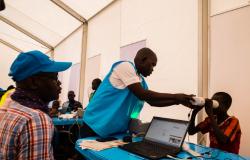Digital ID and Management Information Systems for Humanitarian and Social Protection Response

Caribou Digital and DAI are pleased to share a new report on the issues around the use of information and identification systems in humanitarian and social protection support.
Recently, the systems and technologies through which social assistance and support are delivered have been the focus of greater attention, firstly as the delivery of this support is increasingly in the form of digital cash transfers which require digital systems for their delivery and secondly, as an increasing number of governments have responded to COVID-19 with direct cash transfers to mitigate the economic impact of the crisis.
Data systems to register and identify recipients of transfers underpin everything in a targeted distribution system in terms of who is eligible, who is not, why, for what and for how long. Data collection for these systems is often the first contact point between crisis-affected populations and responders. Our recent research on this topic explores the feasibility of humanitarian and aid Management Information Systems (MIS) being designed to link with social protection systems and to support a transition, in the long-term, to state social assistance. While it provides global recommendations based on a literature review and key informant interviews with a range of stakeholders at a global level, case studies focused on Fragile and Conflict Affected States (FCAS), namely Yemen and South Sudan.
Findings
There is potential value in leveraging shared data for increased coordination amongst social protection and humanitarian actors, with many believing this reduces duplication of efforts, introduces cost savings and increases effectiveness due to greater insights into coverage and effectiveness. Most claimed that the principal driver for increased interoperability is efficiency, often conflated with the broader concept of “value for money” (VfM).
There is a trend towards consolidation of larger systems in humanitarian contexts, and these systems are commonly viewed as proprietary, with implementing agencies offering donors a unique proposition when considering financing options. Linked to this, many assume centralised humanitarian transfer systems may form the basis of longer-term or government-led social protection systems. However, these assumptions should be challenged for often not adequately protecting rights to privacy and data protection, with potential consequential effects on other fundamental rights of beneficiaries.
Technology and data processing have uses and consequences that at present are poorly understood by many humanitarian practitioners, project managers and policy advisers. This includes a lack of understanding of organisation and grantee approaches to data protection. In many national and international NGOs there was a reportedly high level of insecure data collection, processing, and storage practices such as the use of platforms in insecure ways, including unencrypted Excel, Google Sheets and email. This underscores the importance of ensuring staff at all levels are aware of and understand such policies.
The inadvertent and deliberate leaking and sharing of personal and anonymised data is inevitable. There is clearly a need for capacity, systems and standards that better support data protection, but the operating assumption must be that all collected data are likely to be exposed at some point. Even the most secure cryptographic technologies are at risk with contemporary computing advances. Recommendations to address this, such as implementing data minimisation measures, are discussed below.
Recommendations and Ways Forward
The implications of the type of MIS selected and levels of interoperability are not only a consequence of the technology in and of itself. In this section, we outline recommendations and ways forward related to different models of linking MIS, not only through the technology, but also ways of working and frameworks within which to work which protect individuals, whilst reaping benefits of increased data sharing.
Integration and interoperability: Greater collaboration and data sharing within the humanitarian sector should be supported, but through standardisation (interoperability of secure MIS) rather than a single system. Interoperability would enable different systems to ‘read’ each other. Examples of standards for data exchange include the Humanitarian Exchange Language (HXL), while interoperability should also be based on data sharing minimisation — for example through further use of ‘zero knowledge proofs’ — verifying claims without sharing data. Interoperability should also be furthered through opening ‘closed’ systems, such as SCOPE, ProGres, PRIMERO and BRAVE, using APIs to enable third parties to unlock data monopolies and enabling the development of further services.
Conceptual framework — digital dignity: This issue is particularly prevalent where data are being shared amongst organisations or MIS are made interoperable. Individuals need to be respected as a data agent, and not purely as a data subject, in the way data are governed, to ensure that data governance aligns with core humanitarian and development principles. The promotion of digital dignity relies on the adoption of appropriate data protection standards and digital do no harm standards and protocols, as well as Value for Money and Leave No-One Behind.
Data protection standards: Policies and reporting should be aligned to an agreed sector specific international data protection regime, aligned with the EU GDPR and any applicable local data protection regime, but tailored to reflect the specificities of the sector and context, before data are shared or MIS made interoperable. This will ensure all involved in data sharing are committed to the same principles, and is particularly important as very few countries, especially the fragile and conflict affected states in which humanitarian response takes place, have any data protection policies or standards at all.
Ways of working: Donor/aid agencies should develop a global multi-disciplinary community of practice on management information systems (MIS) interoperability, including humanitarian and development perspectives, spanning from aid policy to legal, protection and safeguarding, and IT expertise. The key task of the above body should be to create or appoint an independent international data protection body whose main output would be the creation and oversight of a data protection standard suitable for application in FCAS. Existing bodies, such as the Independent Aid Transparency Initiative (IATI), the Social Protection Inter-Agency Cooperation Board (SPIAC-B), and Interagency Social Protection Assessments (ISPA) serve as examples or could extend to include MIS.
Options for implementation — contractual or voluntary: The MIS data protection standard could be implemented in two ways. The first is through collective legal and contractual enforcement of a common approach by all major donors i.e. obligations being included in contracts or grant agreements issued. Alternatively, an aspirational voluntary code of practice could be developed which implementers are encouraged to meet (in part through appropriate donor funding reward or penalty). This could come from a voluntary scheme which sets a standard and encourages aid agencies to meet it.
Biometrics: Biometric data are recognised as being particularly powerful for driving system efficiencies — for example, by ensuring de-duplication of access to transfers. There is a significant trend towards their use, in many cases without due consideration for the implications. Due to their immutability and uniqueness, biometrics raise considerable safe data storage risks and require commensurate risk management measures. GDPR categorises biometric data in a special category, leading to stricter guidelines on storage and sharing, so adherence to this or GDPR-like protocols will help assure the security of this data. Organisations such as ICRC have excellent biometric data protocols (link). It is also important for donors and implementers to note that their choices regarding biometric data use may become embedded in future government-led social protection, so humanitarian and development actors must ensure that their choice of biometric data is appropriate and that essential safeguards are in place.
Basis for data processing: Where consent is relied on as the legal basis for data processing, greater efforts by aid agencies to obtain informed, unambiguous, and freely given consent are needed. The degree of consent required, sought and provided to those registered on MIS is by and large inversely proportional to humanitarian need, potentially allowing for (or even requiring) other legal bases for data processing to be relied on (see sections on Basis for Data Processing and Consent, in the full report). However, when using data for other purposes in the future, this should not be an excuse to deprioritise consent as a fundamental right of those registered — consent should be gathered for every intended use where it will be relied on as a legal basis for data processing. Where intended future use of data is unclear (for example, in FCAS where there is little clarity regarding the future shape and composition of the domestic government) it will likely be inappropriate to rely on consent as a legal basis for onward data sharing and processing. Data subjects cannot be expected to provide truly informed consent for these ambiguous intended uses. If and when conditions are conducive for the creation of government-lead MIS, informed consent must be obtained afresh (or potentially for the first time, depending on the circumstances surrounding initial data collection) from those registered during a crisis. This implies that data previously collected by an independent agency (UN, NGO, private sector supplier) under a different legal basis should not be accessible to a government authority.
Risk management: Donors and aid agencies should introduce data risk assessments and response plans as standard to all MIS activities. A standard, structured Data Protection Impact Assessment approach should be developed and undertaken for humanitarian contexts, including consideration of risks to civilian protection. During transition, donors and aid agencies should encourage domestic governments to take up similar approaches, and should support their efforts to do so as outlined above.
Background to our study
This research was motivated by a recognition that the information systems used to manage the provision of support are often disconnected and fragmented within humanitarian response, within state assistance and between humanitarian and state social protection systems. This can have negative consequences, such as duplication or exclusion from assistance, implications for data protection, and can lead to confusion for users. This fragmentation is particularly significant given an increasing focus on the ‘nexus’ between emergency response, humanitarian aid and longer term development assistance and a desire amongst the international community to see a transition of support from humanitarian assistance to assistance delivered through state systems.
Cash transfers are an increasingly common means of providing state social assistance, while their use in humanitarian aid is also increasing. State social assistance helps build people’s resilience before and during crises, increasing people’s capacity to resist and respond to shocks. At the same time, humanitarian cash transfer programmes are expected, by some, to provide building blocks for longer-term systems, some attributes of which might be adopted in / transferred to a future national approach.
Our report focuses on the identification and registration systems that underpin these cash transfer programmes as part of wider information management throughout a humanitarian response, including protracted and recurrent crises, and at the nexus between humanitarian and developmental approaches. The research aims to identify the implications of separate and disconnected systems on response and ongoing programming following humanitarian crises in the transition to developmental approaches, or during protracted or recurrent crises. It seeks to identify stakeholders’ different priorities and concerns and articulate any apparent trade-offs in these priorities. The research also explores the feasibility of humanitarian aid MIS being designed to link with social protection systems and to support a transition, in the long-term, to state social assistance.
This research was produced by DAI and Caribou Digital contracted through the Expert Advisory Call Down Service (EACDS) Lot B service ‘Strengthening resilience and response to crises’, managed by DAI Europe Ltd and funded by the UK Department for International Development.
The views expressed in this document are entirely those of the authors and do not necessarily represent the UK Department for International Development’s views or policies, or those of DAI or Caribou Digital. Comments and discussion on items related to content and opinion should be addressed to the authors, via info@lotb-resilience.org.
Image: Biometric Registration in Bidi Bidi Camp, Northern Uganda (photo: author)

